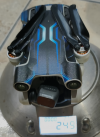Since the very early days of cinematography there has been something called the 180 degree rule. On the first film cameras the rotating shutter was open for 180 degrees then closed for 180 degrees, exposing the film frame then moving to the next frame of film and repeat. That became the aesthetic of film at 24 fps with that amount of motion blur in the image. That rule is still followed today in feature films and television. If you want to work professionally with your drone you need to understand this. The other night I was shooting for a network television broadcast of a football game at a stadium. I was matching up to other stadium cameras so I was outputting 60i or 59.94 fps on my cendence controller to the mobile from an DJI
Inspire 2. My shutter speed was 1/60th. If I was shooting at 24 fps gathering stock footage for production my shutter speed should be 1/48th on a broadcast camera but 1/50th is very close and acceptable on a drone. If you shoot without ND at a high shutter speed the footage looks very electronic and lacks natural motion blur and would not be acceptable for acquisition by a production house or broadcaster.











